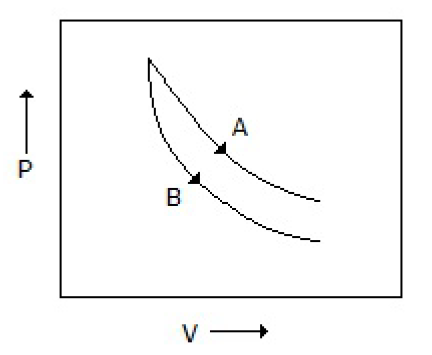Pick out the Clausius-Clapeyron equation from the following:
dP/dT = ΔH/TΔV
ln P = - (ΔH/RT) + constant
ΔF = ΔH + T [∂(ΔF)/∂T]P
None of these
Correct Answer :
B. ln P = - (ΔH/RT) + constant
Related Questions
In case of an __________ process, the temperature of the system increases.
Isothermal compression
Isothermal expansion
Adiabatic expansion
Adiabatic compression
The number of degrees of freedom for a mixture of ice and water (liquid) are
3
2
1
0
Which of the following non-flow reversible compression processes require maximum work?
Adiabatic process
Isothermal process
Isobaric process
All require same work
For an ideal liquid solution, which of the following is unity?
Activity
Fugacity
Activity co-efficient
Fugacity co-efficient
Pick out the correct statement.
A real gas on expansion in vacuum gets heated up
An ideal gas on expansion in vacuum gets cooled
An ideal gas on expansion in vacuum gets heated up
A real gas on expansion in vacuum cools down whereas ideal gas remains unaffected
A cyclic engine exchanges heat with two reservoirs maintained at 100 and 300°C respectively. The maximum work (in J) that can be obtained from 1000 J of heat extracted from the hot reservoir is
349
651
667
1000
__________ does not change during phase transformation processes like sublimation, melting & vaporisation.
Entropy
Gibbs free energy
Internal energy
All (A), (B) & (C)
The rate at which a substance reacts is proportional to its active mass and the rate of a chemical reaction is proportional to the product of active masses of the reacting substances. This is the
Lewis-Randall rule
Statement of Van't Hoff Equation
Le-Chatelier's principle
None of these
Entropy change of the reaction, H2O (liquid) → H2O (gas), is termed as the enthalpy of
Solution
Vaporisation
Formation
Sublimation
In which of the following reaction equilibrium, the value of equilibrium constant Kp will be more than is Kc?
2HI H2 + I2
N2O4 2NO2
2SO2 + O2 2SO3
None of these
Which of the following is not a unit of the equilibrium constant Kp? (where, Δx = number of moles of products number of moles of reactants)
(atm)Δx, when Δx is negative
(atm)Δx, when Δx is positive
Dimensionless, when Δx = 0
(atm)Δx2, when Δx > 0
In case of a close thermodynamic system, there is __________ across the boundaries.
No heat and mass transfer
No mass transfer but heat transfer
Mass and energy transfer
None of these
In any spontaneous process,
Only F decreases
Only A decreases
Both F and A decreases
Both F and A increase
Consider the process A & B shown in the figure given below: In this case, it is possible that

Both the processes are adiabatic
Both the processes are isothermal
Process A is isothermal while B is adiabatic
Process A is adiabatic while B is isothermal
The third law of thermodynamics states that the
Heat capacity of a crystalline solid is zero at absolute zero temperature
Heat transfer from low temperature to high temperature source is not possible without external work
Gases having same reduced properties behaves similarly
None of these
Absorption/evolution of heat during conversion of a substance from one allotropic form to another is termed as the heat of
Sublimation
Fusion
Transition
Vaporisation
For a thermodynamic system containing 'x' chemical species, the maximum number of phases that can co-exist at equilibrium is
x
x + 1
x + 2
x + 3
Equation which relates pressure, volume and temperature of a gas is called the
Equation of state
Gibbs Duhem equation
Ideal gas equation
None of these
The necessary condition for phase equilibrium in a multiphase system of N components is that the
Chemical potentials of a given component should be equal in all phases
Chemical potentials of all components should be same in a particular phase
Sum of the chemical potentials of any given component in all the phases should be the same
None of these
Gases are cooled in Joule-Thomson expansion, when it is __________ inversion temperature.
Below
At
Above
Either 'b' or 'c'
In a working refrigerator, the value of COP is always
0
< 0
< 1
> 1
In case of a reversible process (following pvn = constant), work obtained for trebling the volume (v1 = 1 m3 and v23 m3) is maximum, when the value of 'n' is
0
1
y = 1.44
1.66
The number of degrees of freedom for an azeotropic mixture in a two component vapour-liquid equilibria is/are
Zero
One
Two
Three
Two substances are in equilibrium in a reversible chemical reaction. If the concentration of each substance is doubled, then the value of the equilibrium constant will be
Same
Doubled
Halved
One fourth of its original value
The melting point of paraffin wax (which contracts on solidification) __________ with pressure rise.
Increases
Decreases
Remains unchanged
Decreases linearly
Which is a state function?
Specific volume
Work
Pressure
Temperature
What is the value of Joule-Thomson co-efficient for an ideal gas?
+ve
-ve
0
∞
In case of the decomposition of hydroiodic acid (2HI H2 + I2), addition of H2 (at equilibrium condition) will
Increase the partial pressure of I2
Decrease the partial pressure of HI
Diminish the degree of dissociation of HI
None of these
Pick out the wrong statement.
A closed system does not permit exchange of mass with its surroundings but may permit exchange of energy.
An open system permits exchange of both mass and energy with its surroundings
The term microstate is used to characterise an individual, whereas macro-state is used to designate a group of micro-states with common characteristics
None of the above
Which of the following is not a reversible process?
Expansion of an ideal gas against constant pressure
Atmospheric pressure vaporisation of water at 100°C
Solution of NaCl in water at 50°C
None of these
